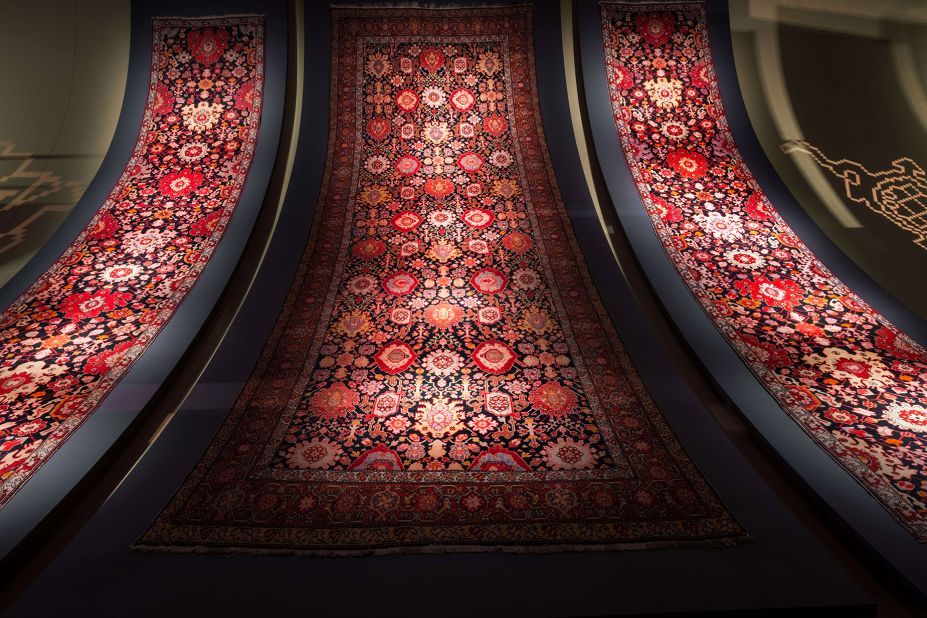CNN posts article on Azerbaijani carpet weaving

CNN TV channel's internet website has published an article on traditional art of Azerbaijani carpet weaving, Azernews reports.
“For some, home is where the heart is. In Azerbaijan, however, the saying goes, “xalçam harada, yurdum orada,” meaning “wherever my carpet is, that’s where I live.”
Azerbaijan’s love affair with carpets is an inextricable one — a much-revered art form that’s been woven into its cultural DNA since the Bronze Age and fervently preserved thereafter. Today, carpets are an intrinsic part of daily life.
They are found everywhere: on the walls and floors of homes and restaurants, displayed in heaps outside souvenir shops and strewn over bonnets of rusty Ladas parked roadside. Some are woven for special occasions: births, weddings, birthdays and burials,” the article says.
“Weaving techniques are passed down from generation to generation — and each carpet has a unique story to tell. They’re such an artistic phenomenon that in 2010, UNESCO inscribed traditional Azerbaijani carpet weaving onto the Representative List of the Intangible Cultural Heritage of Humanity.
In the country’s capital, Baku, the beloved carpet’s most striking embodiment comes in the form of a building shaped, rather remarkably, like a gargantuan, half-rolled carpet decorated with a golden geometric pattern. The Azerbaijan National Carpet Museum, designed by Austrian architect Franz Janz, sits proudly on the city’s buzzy seaside promenade.
Its three floors house a kaleidoscope of Azerbaijani carpets — modern and traditional, pile and flat-woven, small and larger-than-life — as well as textiles, ceramics, jewelry and traditional costumes. The 6,000 or so carpets, dating from the 17th century to the present day, hail from different regions across the country, from the shores of the Caspian Sea to the hinterlands of mountainous Karabakh.
The museum was founded in 1967 by renowned artist and carpet weaver Latif Karimov, who dedicated his life to celebrating and preserving Azerbaijani carpets. It was, at the time of opening, the very first museum of its kind. It has been standing in its current location since 2014 and serves as a vital research and education center.
A short distance from the museum, in Baku’s UNESCO-listed Old City, is Azerkhalcha, an organization dedicated to preserving the age-old tradition of carpet weaving and championing the women who devote their lives to it. One of them is 61-year-old Sevinj Hajiyeva, who was taught how to weave by her brother when she was just 6,” the author mentions.
“Carpet weaving is not just an art; it’s a profound passion, a source of love, and a lifelong companion,” she tells CNN. “My greatest aspiration is to pass on this art to the younger generation.” For Sevinj, weavers in Azerbaijan often share emotions and ideas through carpets, “treating them as cherished creations akin to their own children.”
“First, the sheep is reared for its wool — this is usually done during spring or autumn — which is then washed, spun and dyed before the yarn is woven in either horizontal or vertical looms. Natural, ancient dyeing techniques are still the most favourable in Azerbaijan. They are extracted from plants, fruits and vegetables, such as red onion, saffron, nut shells and pomegranates. These age-old techniques have vehemently stood the test of time.
But it’s not all about the past and unyielding tradition. One Azerbaijani artist, Faig Ahmed, is known for deconstructing typical carpets and “defiling” them with new, three-dimensional patterns, quite literally interthreading traditional styles with overtly abstract, almost psychedelic patterns,” the article underlines.
“For me, as an Azerbaijani artist, the carpet represents a localized artistic language through which one can express global themes,” Ahmed tells CNN Travel. “In Azerbaijani culture, a carpet represents a multilayered connection of history, tradition, social norms, religion, politics and geography. This signifies a deep-rooted link between Azerbaijan’s geography and culture.”
“Today, the preservation of carpet weaving is so important to Azerbaijan that it is taught in some universities and colleges across the country. The Azerbaijan State University of Culture and Arts in Baku, for example, offers a bachelor’s degree in Decorative, Applied Art (carpet, weaving).
For tourists, there are carpet weaving workshops all around the country, including the Qadim Quba in Azerbaijan’s northern Quba region. And, with the likes of Faig Ahmed and Azerkhalcha — who are at once preserving ancient traditions and propelling them into the 21st century — it’s safe to say carpets will remain firmly stitched into the tapestry of Azerbaijani culture for generations to come,” the author emphasizes.
---
Follow us on Twitter @AzerNewsAz
Here we are to serve you with news right now. It does not cost much, but worth your attention.
Choose to support open, independent, quality journalism and subscribe on a monthly basis.
By subscribing to our online newspaper, you can have full digital access to all news, analysis, and much more.
You can also follow AzerNEWS on Twitter @AzerNewsAz or Facebook @AzerNewsNewspaper
Thank you!
